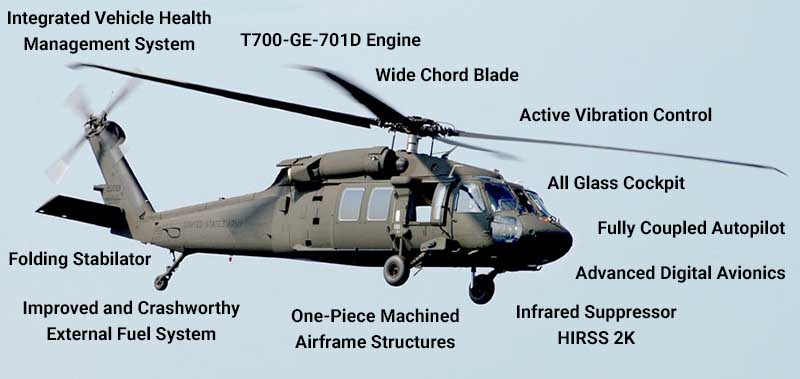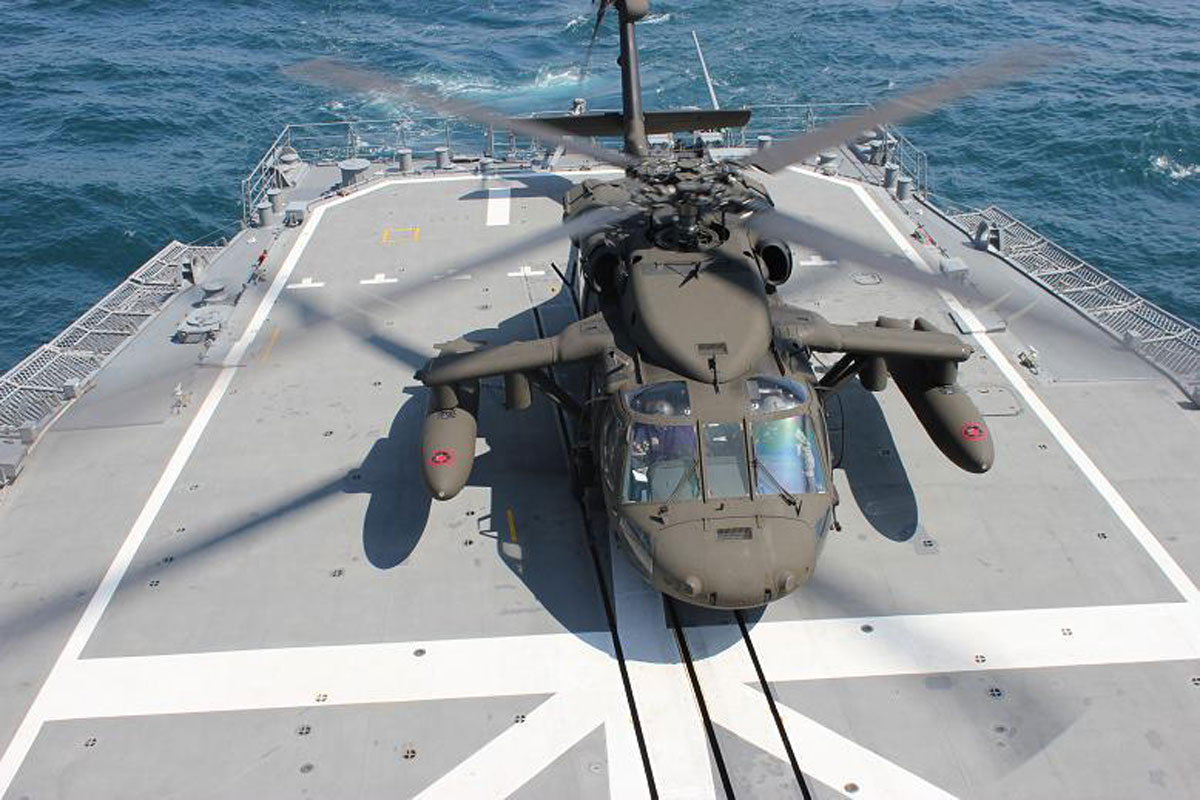UH-60: Advancements in Modern Helicopter Style
The UH-60 helicopter stands as a criteria in modern air travel, showcasing substantial advancements in style and technology that cater to the advancing demands of armed forces operations. As we check out the advancement and key advancements of the UH-60, it comes to be important to think about just how these developments influence not just existing applications but also the future landscape of helicopter style.

Development of the UH-60
The development of the UH-60 Black Hawk helicopter represents a substantial landmark in aerospace design and armed forces aviation. Presented in the late 1970s, the UH-60 was created by Sikorsky Aircraft to meet the United States Army's need for a versatile energy helicopter with the ability of carrying out a variety of missions. Its design stressed maneuverability, speed, and sturdiness, establishing brand-new requirements for functional performance.
The UH-60 features a distinctive four-blade blades system, which enhances lift and security, enabling it to operate successfully in diverse settings. Its airframe is constructed from innovative composite materials, adding to a decrease in weight while preserving structural stability. The helicopter's style likewise integrates improved aerodynamics, which enhances gas performance and raises variety.
Throughout the years, the Black Hawk has actually undergone multiple upgrades to improve its capabilities, consisting of improved engines, progressed flight control systems, and modular systems for very easy maintenance and flexibility. The helicopter's capability to perform goals varying from army transport to clinical emptying has strengthened its function as a foundation of united state military procedures. The UH-60 Black Hawk remains an archetype of just how development in helicopter layout can dramatically impact military efficiency and functional adaptability.
Advanced Avionics Solutions
Improvements in avionics systems have actually changed the capacities of modern-day helicopters like the UH-60 Black Hawk, boosting functional performance and situational awareness (UH 60). The integration of sophisticated avionics enables enhanced trip, interaction, and navigation monitoring, making the UH-60 more functional in diverse objective profiles
One of the key functions is the advanced electronic cabin, which utilizes multifunction displays that give real-time data, making certain pilots have immediate accessibility to crucial flight information. This streamlining of details decreases pilot work and improves decision-making procedures throughout complex procedures. In addition, the unification of GPS and inertial navigation systems enables specific positioning and path planning, boosting objective execution in tough atmospheres.
Furthermore, progressed avionics systems improve communication capacities with secure information links and voice interaction systems, enabling seamless control with ground forces and various other aircraft. The assimilation of automatic trip control systems additionally contributes to improved stability and control, specifically in adverse climate conditions or throughout low-altitude maneuvers.
Engine and Performance Enhancements
Engine efficiency in contemporary helicopters has actually taken a substantial leap forward, driven by advancements that enhance performance, power, and integrity. The UH-60 Black Hawk, for instance, utilizes the T700-GE-701C engine, which features a dual-channel, full-authority electronic engine control system.
Moreover, the assimilation of engine health tracking systems enables for real-time diagnostics and anticipating upkeep, dramatically boosting functional dependability. These systems not only alert crews to potential concerns prior to find out they end up being essential yet likewise assist in much more efficient maintenance organizing, therefore lowering downtime.

Materials and Structural Innovations
Current growths in products and architectural layout have transformed contemporary helicopter building and construction, boosting both efficiency and sturdiness. The introduction of sophisticated composite materials, such as carbon fiber strengthened polymers, has actually substantially lowered weight while keeping architectural honesty. This change not just boosts gas performance yet additionally raises haul ability, permitting helicopters like the UH-60 to execute even more varied goals.
Furthermore, advancements in aluminum alloys and titanium elements have added to boosted resistance to corrosion and fatigue, extending the life expectancy of critical airframe aspects. The critical use of these products has led to a decrease in upkeep requirements and boosted general operational preparedness.

Moreover, the assimilation of computer-aided design (CAD) and additive production technologies has actually enabled extra light-weight frameworks and complicated geometries, maximizing the aerodynamic efficiency of helicopter designs. These improvements facilitate fast prototyping and manufacturing, allowing makers to react quickly to advancing mission requirements.
Safety And Security and Survivability Functions
Safety and security and survivability features in contemporary helicopter layout have ended up being extremely important, reflecting the enhancing needs for goal effectiveness in difficult settings. The UH-60 Black Hawk, a notable instance, integrates sophisticated innovations to enhance team and guest security. Among the most critical innovations is the consolidation of crashworthy fuel systems made to reduce the threat of fire during impact. In addition, the airframe is built with strengthened products that soak up and dissipate power, additional protecting passengers in the occasion of a crash.
The helicopter likewise employs a ballistic protection system, which includes armored staff seats and essential systems securing, lowering susceptability to little arms fire and shrapnel. Improved situational understanding is achieved through advanced avionics and sensing unit technologies, allowing pilots to spot and prevent dangers successfully.
In addition, the integration of redundancy in crucial my latest blog post systems-- such as dual engines and numerous trip control networks-- makes sure continued operation even if one system falls short. The UH-60 is furnished with advanced emergency flotation gadgets, enhancing survivability in water landings. Collectively, these features not just enhance the security of personnel however additionally enhance mission success rates in aggressive atmospheres, showing the dedication to excellence in helicopter design.
Final Thought
The UH-60 helicopter stands for a substantial advancement in modern-day aviation modern technology, including ingenious products, cutting-edge avionics, and robust safety and security features. Overall, the UH-60 serves as a benchmark for future growths in helicopter design, symbolizing strength and flexibility in contemporary armed forces operations.
The UH-60 helicopter stands as a criteria in contemporary aviation, showcasing significant improvements in design and modern technology that cater to the evolving needs of military operations. As we discover the evolution and key advancements of the UH-60, it comes to be essential to consider just how these advancements affect not only existing applications however additionally the future landscape of helicopter style.
Introduced in the late 1970s, the UH-60 was created by Sikorsky Airplane to fulfill the United States Military's requirement for a functional utility helicopter qualified of performing a variety of missions. The UH-60 Black Hawk stays a prime example of how innovation in helicopter layout can considerably impact armed forces performance and functional flexibility.
Overall, image source the UH-60 serves as a criteria for future advancements in helicopter layout, embodying strength and flexibility in modern military operations.
 Neve Campbell Then & Now!
Neve Campbell Then & Now! Alfonso Ribeiro Then & Now!
Alfonso Ribeiro Then & Now! Heath Ledger Then & Now!
Heath Ledger Then & Now! Atticus Shaffer Then & Now!
Atticus Shaffer Then & Now! Morgan Fairchild Then & Now!
Morgan Fairchild Then & Now!